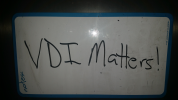First off, let’s get the important dates out of the way and I’ll explain the rest below…
ESXi 6.5 & 6.7 are in Technical Guidance as of 10/15/2022, End of Technical Guidance as of 11/15/2023 (5 months away as of this writing)
vSAN 6.5 & 6.7 are in Technical Guidance as of 10/15/2023, End of Technical Guidance as of 11/15/2023
Horizon 7.13.x is in Technical Guidance as of 4/30/2023, End of Technical Guidance as of 4/20/2025 (10 months away)
Now, what does that all _really_ mean Scotty??
As time goes along, all software eventually faces a Sunset and support for the product will be spun down. After being extended during COVID, two very popular versions of VMware’s ESXi Hypervisor has gone End of General Support (EOGS), specifically ESXi 6.5 & 6.7 (and vSAN with those 2 versions). Along with these two VMware Hypervisors, their long standing VDI product, Horizon 7.13.x, is also being sent off into the sunset… But what does that mean to me and my organization??
Well, the process, timeline and support phases are defined by each software developer. For VMware the timelines are published in their “Product Lifecycle Matrix” located here and their defined phase policies are located here. There are 4 defined dates to each of the phases of a VMware Software product’s life: General Support, End of General Support, End of Technical Guidance and End of Availability.
Let’s start with General Support/General Availability (GS/GA). If it’s a big product, then this date is usually aligned with one of the major Computer Trade Shows like VMware Explore (formerly VMWorld) or at Dell Technolgies World events with all the glitz and glory and promises of releasing the best product on the planet (I won’t go in to discussions of that…), but suffice to say that the GA date is when the product is first released to the public for sale and use and . Sales folk are usually really pumped around that time, but from a support perspective, “customers who have purchased VMware support get maintenance update and upgrades, bug and security fixes and technical assistance as per the Support and Subscription terms and Conditions.” Meaning, if you have a Sev1/Hard down situation and have a support contract, they are on it and will help identify and resolve the problem. Same for Sev2 & 3 issues, but with a little less urgency.
The next important date hits around 2-4 years after the GA release date, depending on the support policies for the developer. For VMware, that date is termed: End of General Support (EOGS). When a product hits this date on the calendar – it moves from GA to Technical Guidance (TG)phase. What to expect from VMware support during this phase is as follows:
“Technical Guidance, if available, is provided from the end of the GS phase and lasts for a fixed duration. Support Services available are reduced where products are in the Technical Guidance Phase. Customers are encouraged to use the Self-Help portal as priority. If required, customers can open a support request online via their Customer Connect portal to receive support and workarounds for low-severity issues on supported configurations only.
During the Technical Guidance phase, VMware does not offer new hardware support, server/client/guest OS updates, new security patches or bug fixes unless otherwise noted. This phase is intended for usage by customers operating in stable environments with systems that are operating under reasonably stable loads.”
ref: https://www.vmware.com/support/lifecycle-policies.html
What this really means is:
- No real Sev1 priority with VMware for products in TG. Your first recommended remediation is to update your software to a supported version.
- Support is contained within your region. Essentially, the product is down to 8×5 support within the region where you are located, with weekday support only.
- No new fixes/patches will be generated if a code problem is found.
For an organization who’s business depends on software to run and execute the business, this is a very precarious position to be in. The whole idea of purchasing an Enterprise grade Hypervisor/VDI/Storage product is to have the safety net of having vendor support to help if something goes wrong in the environment. Being in Technical Support myself, I’ve had to relay this message to more than a few customers during my career and it’s never a happy moment.
After a set period of time the software (and the support for it) rides off towards the horizon (see what I did there?) and is placed in End of Availability/End of Distribution (EOA/EOD) status. If you are still running the software in production at this date and you haven’t downloaded a copy of all the installation softwares to rebuild your environment, you are in big trouble, as the product will be removed from VMware’s download site and all support for the product will be discontinued. Knowledgebase articles will still be hosted by VMware, but may disappear as time goes on.
Bottom line here: Keep up with your software lifecycles and upgrade to stay ahead of TG dates. Look up the EOGS dates for the software you run in your environment and write them down on your whiteboard. The last thing you need is for a software bug/misconfiguration to be a “resume generating event” because an Administrator was playing the card “if it aint’ broke, don’t fix it”. As I’ve always said during my IT career: It takes hard work to be lazy.
